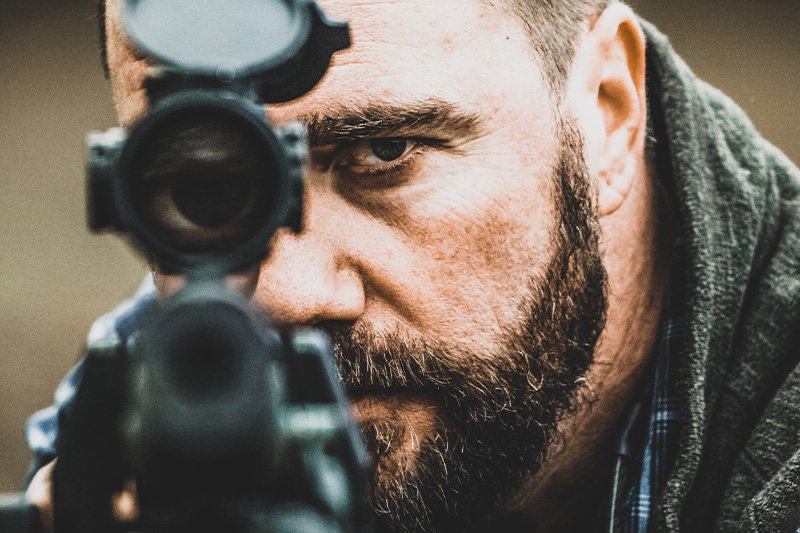STOP WORRYING ABOUT ACCURACY
2021/06/01
By Ryan Cleckner
They key to becoming more accurate is to stop worrying about being accurate.
After years as a U.S. special operations sniper and as a sniper instructor, I’ve noticed a trend that hinders a rifles shooter’s improvement: they focus too much on accuracy.
That’s right. The pursuit of becoming more accurate can, in effect, prevent an improvement in accuracy when it really counts.
I strongly believe that the only way to improve, in any task, is to recognize any shortcomings so that they can be diagnosed and corrected. However, when I see most shooters practicing at the shooting range, they are more concerned with being accurate than they are about exposing weaknesses and improving.
Shooting from a bench, or in the prone, with a scope on the highest magnification setting sure can make for some pretty little groups on paper at the range… it can also result in poor shots in the field. This is because that style of shooting, although great for testing the capabilities of a rifle system or for zeroing your scope, is horrible for encouraging proper trigger control, stability in real-world positions, and properly focusing on the reticle.

My simple mantra to accurate shooting goes something like this, “focus on the reticle, steady pressure on the trigger.”
Focusing on your reticle (or sights) is crucial to becoming a better shooter. Only by focusing on your reticle, instead of the target, can you know where you were aiming when the rifle fires. Modern scopes with very clear glass set on their highest magnification setting can make it very tempting to stare at the crisp and clear pretty target instead of the reticle. If this is happening to you, try turning down the magnification setting and/or shooting at a plainer target.
This goes beyond where you’re focused while shooting, it also includes being honest with yourself about what happened – especially if your shot was not as good as you intended. I encourage all of my students to “call their shots” by saying out-loud exactly where their reticle was as the trigger was pulled. By doing this, they not only become more aware of their reticle’s position, they can also identify if they pulled a shot in a particular direction.
If you know why you missed, you can work to improve. But if you don’t know why you hit, you can’t repeat it.
Shooting from a bench or while prone can hide some of the effects of improper trigger control and worse, it can encourage bad habits.
Surely we agree that stability is one of the keys to accuracy. However, practicing in unstable positions can make you a better shooter because I’ve seen very few shooting benches in the field and the instability can expose poor trigger control.
First, practicing and becoming comfortable in real-world positions will clearly help you prepare to execute an unstable shot in the field. But, it’s also excellent training for improving shooting in general. If you’re shooting from a kneeling position, for example, and you “jerk the trigger,” you’ll see the corresponding movement in your rifle that can sometimes be hidden if the rifle is resting solidly on sandbags on a fixed shooting platform. This is, of course, only if you’re watching your reticle.
In addition to exposing your trigger control weaknesses so that they can be fixed, unstable shooting positions can also teach you to apply proper pressure to the trigger to fire the rifle. If you’re anything like me, you’ve said to yourself while shooting, more than once, “a little left, a little more, slightly lower, right about there, nope a little higher, NOW!” This comes from trying to be too accurate and usually leads to “jerking the trigger.”

Instead of trying to be so perfect that you make a bad shot and support bad habits, I encourage you to pursue something I call “acceptable accuracy.” If you determine that a bullet anywhere within a particular area is acceptable, within an animal’s kill-zone for example, then you should be satisfied with a hit anywhere within the area you’ve defined.
This theory is clearly opposite of the common “aim small/miss small” approach but it works for me and most of my students. Those who try for the dead-center of the acceptable area might “jerk the trigger” in a rush to shoot when the reticle is perfectly aligned or they end up focusing so much on the perfect center that they lose focus on the reticle. By trying to be too perfect, they can miss altogether.
Instead, focus on your reticle and if it is anywhere within the acceptable zone (defined by you), start applying steady consistent pressure on the trigger. When your rifle fires, you’ll have a hit as long as the reticle was somewhere within the acceptable zone. A hit at the threshold of what is acceptable is always better than a miss because I was trying to be too perfect.
Becoming more accurate is a goal we all should be pursuing. However, in that pursuit, don’t forget that practicing shooting should be a means to improve and not an exercise of confirming how accurate you are.
Next time you go to the range, practice in real-world unstable positions so that they become familiar and so your errors aren’t hidden, focus on the reticle so you are aware of where you’re aiming and call your shots so that you can be accountable for what happened, and teach yourself to apply proper trigger control while the reticle moves within an acceptable area instead of forcing a shot while trying to be too precise.
If you do this, you may not have pretty little groups at first but you’ll become a better shooter. Hopefully, the latter is what you’re after. If it is, stop worrying about being so accurate and focus on what you can control: your fundamentals.
Ryan Cleckner
Special Operations Sniper (Retired)
US Army, 1/75 Ranger Bn